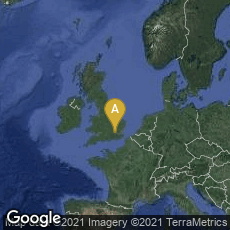

A: London, England, United Kingdom
On January 10, 1863 the first subway system, the Metropolitan Railway, began operation in London. However, smoke from steam engines operating through tunnels caused discomfort for passengers, and limited the appeal of this mode of transport. Between 1863 to 1890 there were numerous proposals to build pneumatic or cable-hauled railways in London to overcome this problem, but none proved successful, until the system was electrified in the 1890s.
"The 3.75-mile (6 km) railway opened to the public on Saturday 10 January 1863. There were stations at Paddington (Bishops Road) (now Paddington), Edgware Road, Baker Street, Portland Road (now Great Portland Street), Gower Street (now Euston Square), King's Cross (now King's Cross St. Pancras) and Farringdon Street (now Farringdon).
"The railway was hailed a success, carrying 38,000 passengers on the opening day, using GNR [Great Northern Railway] trains to supplement the service. In the first twelve months 9.5 million passengers were carried and in the second twelve months this increased to 12 million. The original timetable allowed 18 minutes for the five intermediate stations. Off-peak service frequency was one train every fifteen minutes, increased to one every ten minutes during the morning peak and reduced to one every twenty minutes in the early mornings and after 8 pm. From May 1864, workmen's cheap day returns were offered on the 5:30 am and 5:40 am services from Paddington at the cost of a single ticket (3d).
"Initially, the railway was worked using broad gauge rolling stock provided by the GWR [Great Western Railway] hauled by its Metropolitan Class steam locomotives. Soon after the opening, disagreement arose between the two companies over the need to increase the service frequency and the GWR withdrew its stock in August 1863. The Met continued operating a reduced service with temporary assistance from the GNR using standard gauge rolling stock, before purchasing its own standard gauge rolling stock and locomotives.
"In the belief that it would be operated by smokeless locomotives the first section had been built with little ventilation with a long tunnel between Edgware Road and King's Cross. Initially the smoke-filled stations and carriages did not deter passengers and the ventilation was later improved by making an opening in the tunnel between King's Cross and Gower Street and removing glazing in the station roofs. With the problem continuing after the 1880s conflict arose between the Met, who wished to make more openings in the tunnels, and the local authorities who argued that these would frighten horses and reduce property values. This led to an 1897 Board of Trade report that reported a pharmacist was treating people in distress after having travelled on the railway with his 'Metropolitan Mixture'. The report recommended more openings be authorised but the line was electrified before these were built" (Wikipedia article on Metropolitan Railway, accessed 01-07-2013).